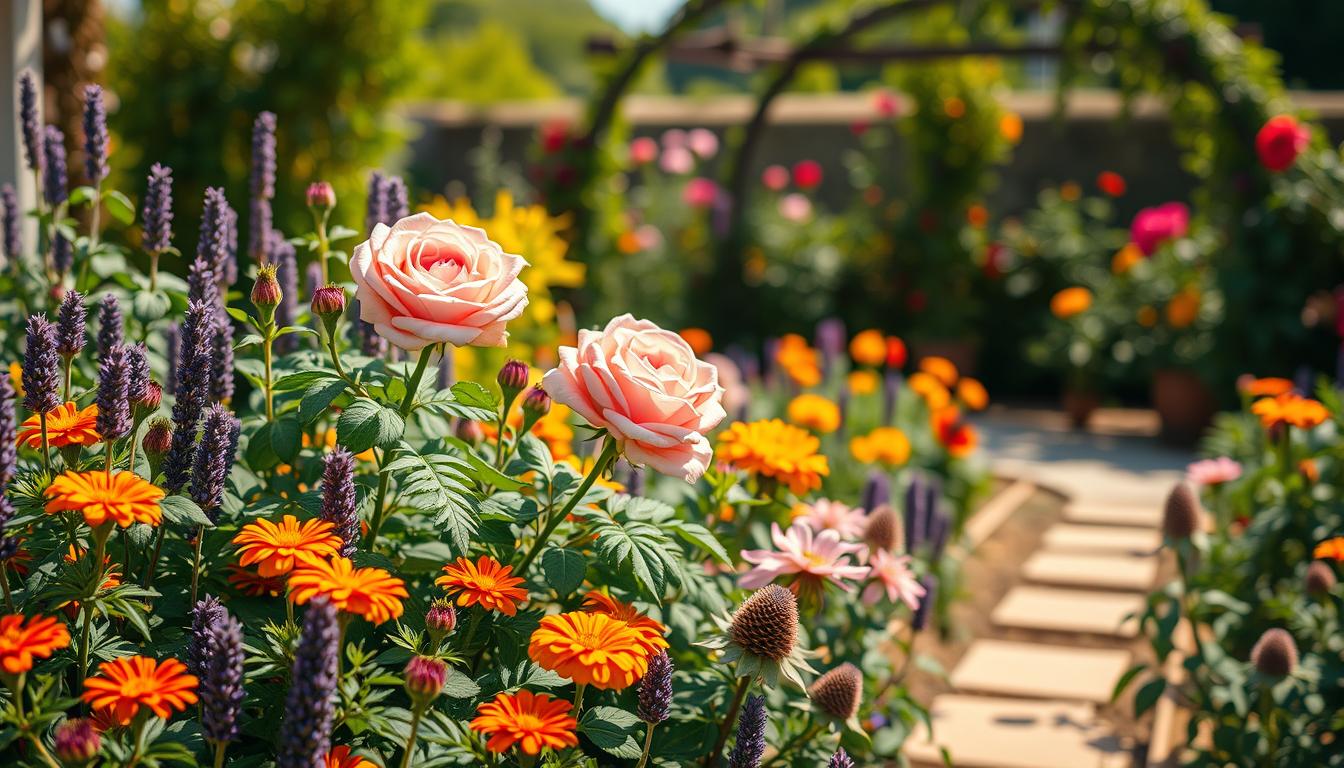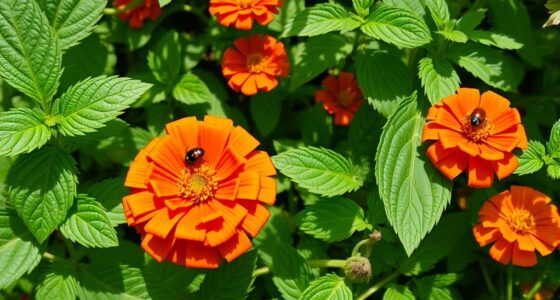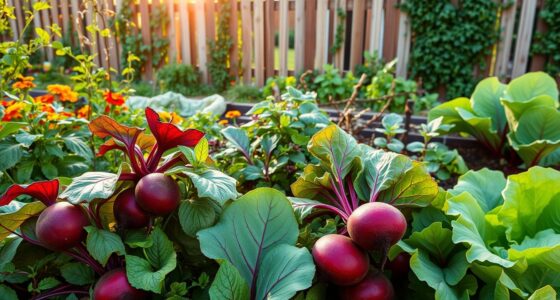As a gardener, nothing compares to the joy of watching your roses flourish. These stunning blooms have a way of brightening your day, and there’s a profound satisfaction that comes with nurturing them from buds to full bloom. Yet, just like us, roses thrive better when they have the right friends by their side. Companion planting is an ancient practice that brings harmony to your garden. By strategically pairing roses with the best companion plants for roses, you not only enhance their beauty but also boost their resilience against pests and diseases. Join me on this journey to explore the remarkable synergy within your rose garden companions and discover how they can elevate your gardening experience.
Key Takeaways
- Companion planting enhances the beauty and health of your rose garden.
- Strategically chosen plants can deter pests and attract beneficial insects.
- Synergy among plants can lead to improved growth and resilience.
- Understanding compatibility is crucial for successful companion planting.
- Experimenting with different combinations can yield delightful surprises.
Why Companion Planting Matters for Roses
Companion planting plays a pivotal role in cultivating healthy roses. This method involves pairing your roses with specific plants that support their growth and health. The benefits of companion planting extend beyond mere aesthetics, helping create a thriving garden ecosystem that supports your roses.
Benefits of Companion Planting
The advantages of companion planting are substantial. Not only does it foster a balanced environment that attracts beneficial insects, but it also optimizes resource utilization among plants. By selecting companion plants that share similar needs for sunlight, water, and nutrients, you can witness improved overall performance in your garden.
How It Enhances Rose Growth
Plants that complement one another can significantly enhance rose growth. By nurturing a diverse range of flora together, you provide a dynamic ecosystem. This natural camaraderie allows for efficient nutrient uptake and promotes healthier foliage and blooms.
Pest Control through Companion Plants
Companion planting serves as a natural pest deterrent. Certain plants effectively keep harmful insects at bay while attracting beneficial pollinators. This interplay cultivates a robust environment conducive to plant health. By implementing a well-thought-out companion planting strategy, you can create a vibrant, pest-resistant rose garden.

Choosing the Right Companion Plants
Selecting the right companion plants for roses can significantly influence the overall health and beauty of your garden. When choosing companion plants, several factors come into play that enhances the success of your rose companion planting.
Factors to Consider
Focus on the following aspects to ensure that the chosen plants support your roses rather than compete with them:
- Soil type: Different plants thrive in various soil conditions. Understand the soil type in your garden to make better selections.
- Water requirements: Consider how much water both the roses and the companion plants need. A mismatch can lead to stressed plants.
- Sun exposure: Know how many hours of sunlight the area receives. Some plants require full sun, while others prefer partial shade.
Climate Compatibility
Climate compatibility plays a vital role in the success of your garden. Ensure that the plants you are considering can thrive in your specific climate zone. Look for varieties suited to your local conditions to promote health and vibrant growth.
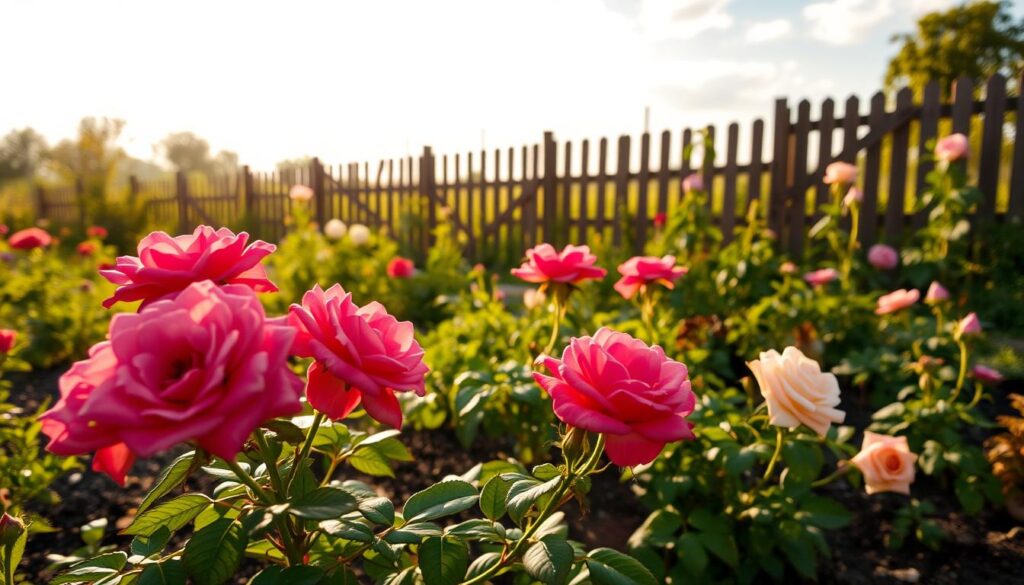
Being well-informed about climate compatibility will help you select the best options, ensuring your roses flourish in harmony with their companions. Thoughtful decision-making regarding these factors enhances not only your garden’s productivity but also its aesthetic appeal.
Popular Companion Plants for Roses
Integrating popular companion plants into your rose garden can significantly enhance the overall health and beauty of your flowers. Each of these companions serves unique purposes, from deterring pests to attracting beneficial insects. Here are some excellent choices to consider for your garden.
Marigolds for Pest Deterrence
Pest deterrent marigolds are a go-to for many gardeners. Their strong scent can repel common rose pests like aphids and whiteflies, keeping your roses healthy and blooming beautifully. By planting marigolds near your roses, you will create a protective barrier that discourages harmful insects.
Lavender for Aroma and Attracting Pollinators
The combination of lavender and roses creates a stunning visual and aromatic display. Lavender not only adds vibrant beauty but also attracts essential pollinators such as bees and butterflies. This pairing benefits both plants as lavender repels certain pests while enticing beneficial insects to your garden.
Catmint for Foliage and Pollinators
Catmint is another fantastic companion for roses. Its fragrant foliage offers visual appeal while attracting a variety of beneficial pollinators. When combined with roses, catmint enhances the garden’s biodiversity, serving as a host for friendly insects that help maintain a healthy environment.
Chives for Natural Pest Control
Chives are an excellent choice for those interested in natural pest control through companion planting. They create a potent barrier against aphids and other harmful insects, while also improving the overall scent of your garden. The integration of chives with roses not only enhances visual appeal but also supports a healthier ecosystem in your garden.
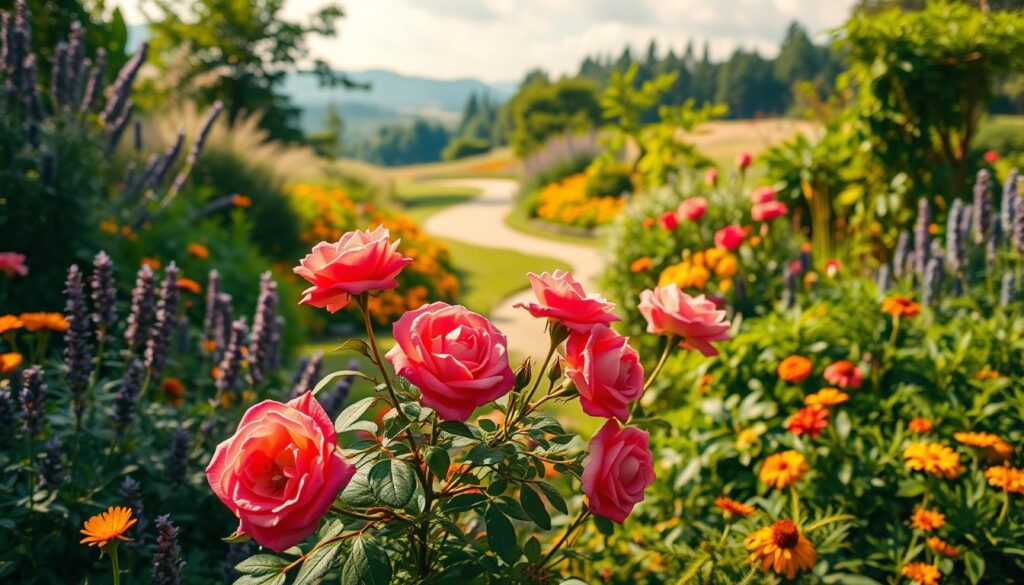
Planting Techniques for Companion Plants
Understanding the right planting techniques is essential when you aim to create a thriving garden with roses and their companion plants. Implementing effective companion planting methodologies ensures your roses benefit from the presence of their friends, promoting not only growth but overall health.
Best Planting Methodologies
One effective approach involves planting companion plants at different heights. Position taller plants at the back of your rose beds while shorter varieties fill in the front. This layering technique maximizes space and allows each plant adequate sunlight. Utilizing beneficial pairings can significantly enhance plant health and vitality, creating a symbiotic environment.
Spacing Your Companion Plants
The spacing of companion plants plays a critical role in their success. Aim to maintain 12 to 18 inches between each plant to prevent competing for resources. Proper spacing aids in air circulation and ensures that all plants receive ample light and nutrients. By adhering to these planting techniques, you foster an environment conducive to fruitful growth.

How to Care for Companion Plants
Caring for companion plants is essential to ensure a thriving garden alongside your roses. Understanding the specific needs of these plants helps create a harmonious environment conducive to growth. Paying attention to the watering needs and fertilization for roses and their companions can significantly impact their health and productivity.
Watering Needs
Companion plants often share similar watering requirements with roses. Establishing a consistent watering schedule helps maintain proper moisture levels in the soil. Regularly examine the soil to determine if it is adequately moist. Aim for well-drained soil, as both roses and their companions can suffer from root rot in overly saturated conditions.
Fertilization Tips
Fertilization for roses and companion plants is crucial for promoting abundance and vibrancy. Using organic fertilizers can enhance soil health, benefiting fruiting and flowering plants alike. Ensure you apply fertilizer during the growing season, following the recommended application rates. This approach minimizes chemical exposure while encouraging healthy root growth across your garden.
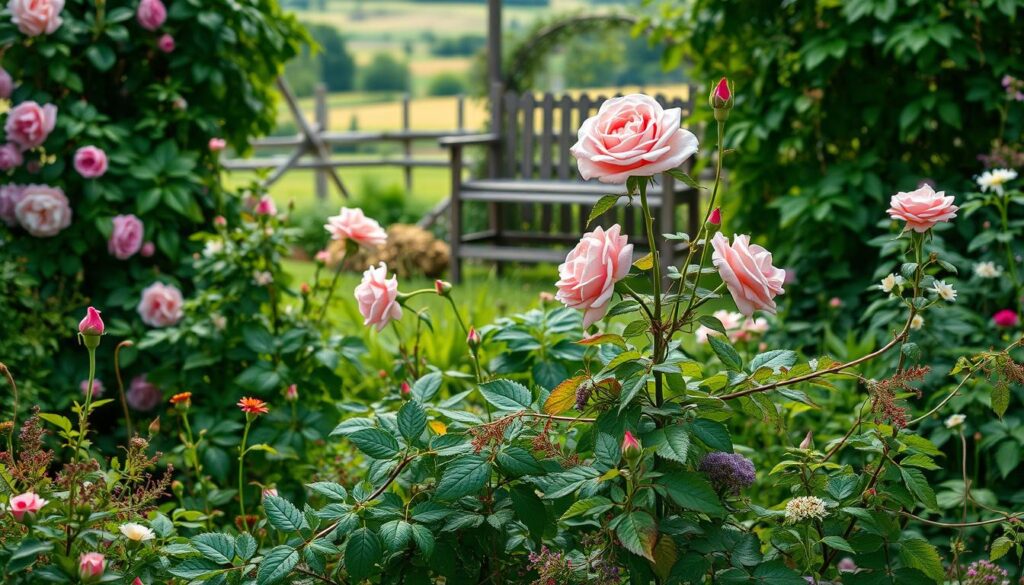
Timing Your Companion Planting
Getting the timing right is essential for successful companion planting with roses. Understanding the best planting seasons allows you to enhance growth and maximize the effectiveness of companion plants. Pay close attention to when you plant your roses and their companions to ensure they thrive together.
Seasonal Considerations
Different plants have unique requirements for timing companion planting. When planning your garden, consider the climate in your area. Roses typically flourish in spring; therefore, aligning your planting activities with seasonal weather patterns ensures that both roses and companions get a great start.
- Early spring is ideal for planting both roses and annual companions.
- Summer planting can work but requires careful attention to watering and care.
- Fall may be a viable option for some perennials if soil conditions are suitable.
Best Planting Times for Roses and Companions
For the best times for roses, aim to plant them during early to mid-spring. This period typically offers milder temperatures and adequate moisture, setting the stage for robust growth. Incorporating companion plants during this time will allow for a vibrant garden throughout the growing season. Early to mid-spring is particularly suited for planting:
| Companion Plant | Ideal Planting Time | Growth Characteristics |
|---|---|---|
| Marigolds | Early Spring | Deters pests; blooms in summer |
| Lavender | Mid-Spring | Attracts pollinators; aromatic foliage |
| Chives | Early Spring | Natural pest control; culinary herb |
Paying attention to timing your companion planting can make a significant difference in the overall health and beauty of your garden. By choosing the right planting seasons wisely, you can create a flourishing environment for both your roses and companion plants, benefiting your garden throughout the year.

Troubleshooting Companion Plant Issues
Even the best-planned gardens can face challenges. Recognizing early signs of poor compatibility can help you save your garden from potential setbacks. When troubleshooting companion plants, it’s essential to be observant of how each plant interacts with its neighbors.

Signs of Poor Compatibility
Look for indications that plants are not harmonizing well. Common signs include:
- Wilting or yellowing leaves
- Stunted growth
- Visible nutrient deficits, such as leaf discoloration
- Competition for light and space, leading to overcrowding
By keeping an eye out for these signs, you can mitigate compatibility issues before they escalate.
Common Problems and Solutions
If you encounter common plant problems, you have options to consider. Here are approaches to improve situations:
- Reassess plant placement to ensure sufficient space and light
- Consider relocating specific plants to enhance their growth potential
- Increase soil nutrients if deficiencies are noted
- Implement better irrigation practices to avoid water stress
Addressing these compatibility issues proactively can foster a healthier and more productive garden environment.
Advanced Companion Planting Strategies
Embracing advanced strategies in companion planting can significantly improve your garden’s productivity and health. One of these techniques is rotational planting, which involves changing the placement of your plants each season. This method helps rejuvenate the soil and combat disease build-up that can occur with static arrangements. Another effective approach is layering companion plants, which optimizes garden space and enhances overall aesthetic appeal by incorporating plants of varying heights and textures.
Rotational Planting Techniques
Rotational planting allows you to maintain soil vitality and reduce the risk of crop diseases. By shifting plants to different locations within your garden, you can ensure that nutrients are replenished and soil-borne pathogens are limited. This practice not only benefits your roses but the companions you choose, as well. Implementing this advanced strategy encourages a dynamic ecosystem that promotes longer-term health and productivity.
Layering Plants for Diversity
Layering companion plants creates a diverse and visually striking planting scheme. Utilizing plants of various heights ensures that each gets adequate sunlight while maximizing vertical space. This method fosters a robust plant community that supports biodiversity. Effective layering generates an environment where beneficial insects thrive, while making your garden more visually appealing. By combining colors, textures, and growth habits, you enhance both the ecological balance and the beauty of your roses and their companions.

Incorporating Herbs with Roses
Bringing herbs into your rose garden creates a delightful blend of beauty and utility. Incorporating herbs like basil and thyme not only complements your roses but also provides practical advantages that can help your garden flourish.
Basil as a Companion Plant
Basil is a superb option for companion planting with roses. This fragrant herb not only enhances the overall aesthetic appeal but actively repels pests. The aromatic oils in basil can help deter flies and mosquitoes, keeping the roses healthier. Planting basil alongside your roses can also create a visually appealing contrast, as the deep green leaves of basil harmonize beautifully with the vibrant colors of rose blooms.
Thyme for Ground Cover and Pest Control
Thyme with roses offers a dual benefit. It acts as an excellent ground cover, effectively suppressing weeds while maintaining moisture in the soil. Additionally, thyme attracts beneficial insects that contribute to pest control, creating a healthier environment for your roses. With its low-growing habit and lovely scent, thyme not only supports rose health but also enhances the garden’s overall fragrance.
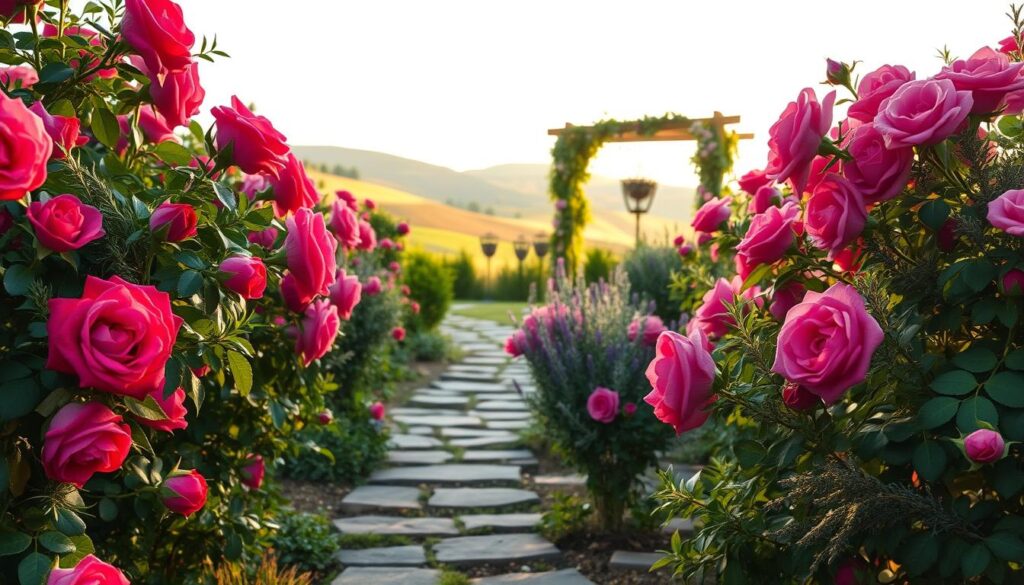
Flowers that Complement Roses
When enhancing your rose garden, selecting the right flowers that complement roses can make a significant impact. Not only do they add visual appeal, but they also support the overall health of your plants. Two standout options include echinacea and yarrow, both of which provide cultivation and ecological benefits.
Echinacea for Color and Pollinator Support
Echinacea, or coneflower, is well-regarded for its stunning petals and ability to attract various pollinators. When you plant echinacea and roses together, you create a vibrant color palette that catches the eye. The striking blooms serve as a magnet for bees and butterflies, vital for the pollination of your floral arrangements. Including echinacea in your garden enhances not only the aesthetic but also the ecological interactions vital for thriving ecosystems.
Yarrow for Attracting Beneficial Insects
Yarrow is another excellent choice known for its hardiness and ability to attract beneficial insects, including predatory wasps and ladybugs. These insects help control pest populations in your garden, leading to a healthier environment. With yarrow for pollinators, you’ll notice improved pollination rates, directly benefiting the growth of your roses. Integrating yarrow alongside your roses maximizes both beauty and functionality, helping maintain a well-balanced garden ecosystem.

Companion Plants that Deter Pests
Integrating pest deterrent companion plants into your garden can significantly enhance the health of your roses. Two standout options are nasturtiums and borage, each offering unique benefits in protecting your valuable plants from harmful pests.
Nasturtiums to Lure Aphids Away
Nasturtiums serve as a fantastic trap plant. Their enticing foliage attracts aphids, which often target roses. By drawing these pests away, nasturtiums protect your roses from damage. This natural strategy keeps your roses thriving while maintaining a vibrant garden aesthetic.
Borage for Attracting Bees
Borage is another excellent choice for companion planting. This herb not only brings an influx of bees, essential for pollination, but its leaves repel certain pests. By planting borage alongside your roses, you create a harmonious ecosystem that supports rose health and promotes an environment teeming with beneficial insects.
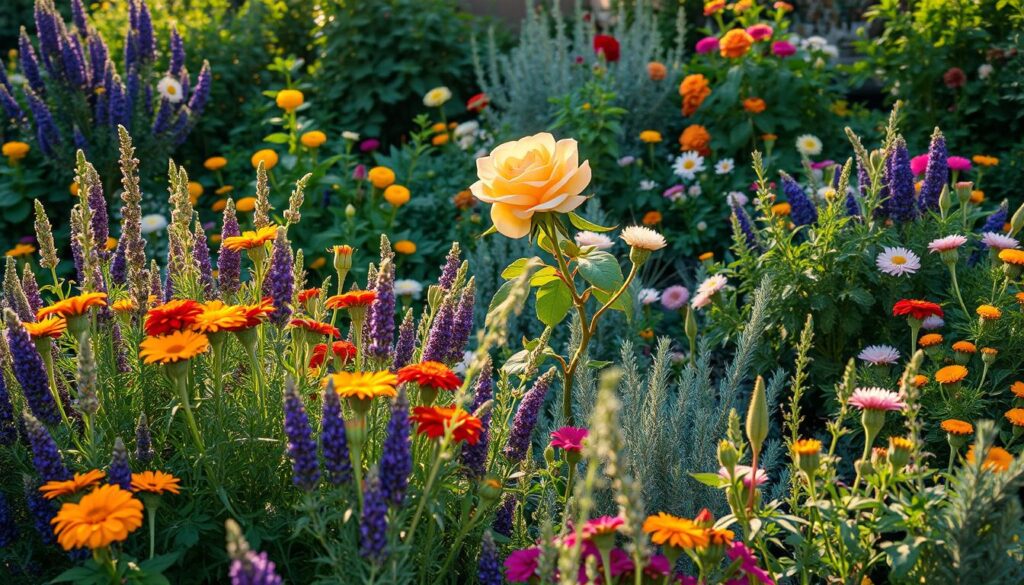
Enhancing Rose Aesthetics with Companions
Creating an inviting and visually appealing rose garden involves more than just selecting the perfect rose varieties. By focusing on enhancing rose aesthetics through thoughtful color coordination and incorporating textural variety, you can elevate the overall beauty of your garden space.
Color Coordination with Companion Plants
Color coordination plays a crucial role in unifying a garden’s aesthetic. Pairing roses with companion plants can provide vibrant contrasts that draw the eye. Consider using cool-toned flowers, such as blue delphiniums or white daisies, alongside warm pink or red roses. This combination not only enhances the visual appeal but also creates a harmonious balance in your garden.
Textural Variety Through Companion Plants
Incorporating plants with varying textures will further enrich the experience of your garden. Different leaf shapes, sizes, and growth habits can complement the lush foliage of roses. For instance, the soft, feathery leaves of astilbe contrast beautifully with the sturdy, broad leaves of hybrid tea roses. This textural variety adds depth and interest, making your rose garden a more dynamic space to explore.
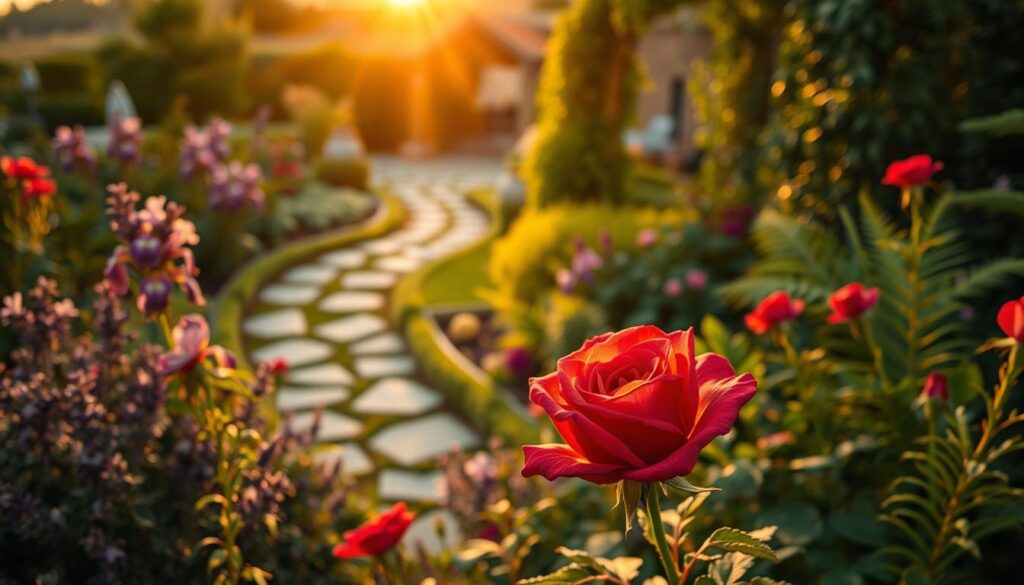
Sustainable Practices with Companion Planting
Adopting sustainable companion planting can transform your rose garden into an eco-friendly haven. By focusing on organic practices, you reduce the negative impact of harmful chemicals, promoting a healthier growing environment. These methods not only benefit your roses but also support local biodiversity, making your garden a thriving ecosystem.
Organic Methods to Consider
When integrating sustainable companion planting into your garden, explore various organic methods. Utilizing natural fertilizers such as compost enriches the soil without the drawbacks of synthetic options. Incorporating pest-repellent plants like marigolds or nasturtiums will protect your roses and encourage beneficial insects. This approach fosters a thriving garden while embracing the principles of sustainable practices.
Reducing Chemical Use in Your Garden
Reducing chemicals in your garden is crucial for environmental health. Companion planting plays a vital role in this objective by naturally deterring pests and diseases. You can minimize the need for chemical pesticides by strategically positioning companion plants. This not only protects your roses but aligns your gardening habits with sustainable practices, creating a positive ripple effect for the garden ecosystem.
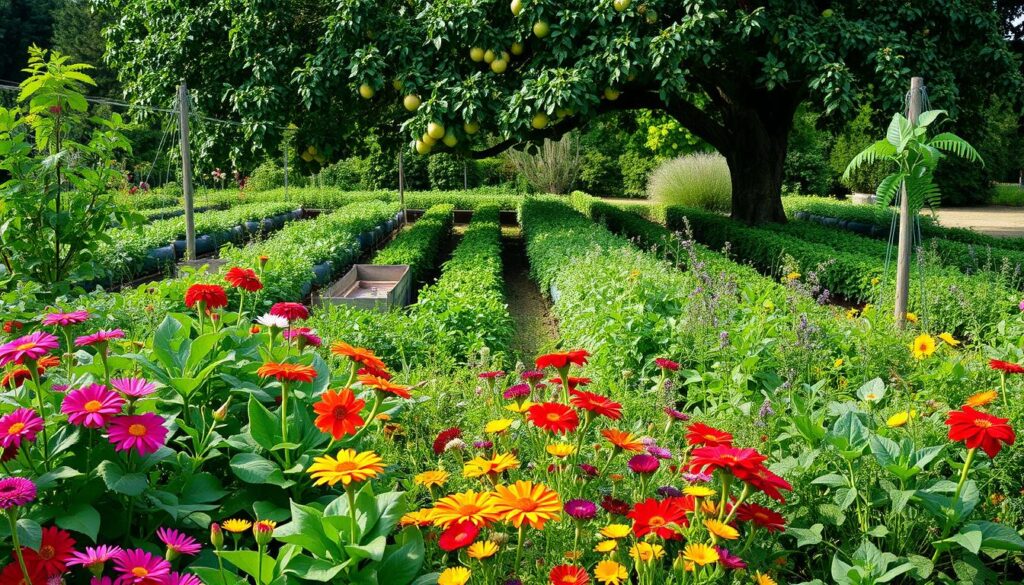
Evaluating Success of Companion Plants
Knowing how to assess the effectiveness of your companion plants plays a significant role in the success of your rose garden. Through evaluating companion plants, you can identify which combinations thrive and which may require change. A close eye on your garden will reveal insights into the overall ecosystem.
Observing Growth and Health
When you start observing growth, pay attention to both the roses and their companion plants. Signs of robust growth, vibrant colors, and lush foliage indicate positive interactions. Conversely, any signs of wilting, discoloration, or stunted growth can suggest compatibility issues. Consider maintaining a journal to track these observations. Noting patterns over time can be beneficial for making informed decisions.
Adjusting for Better Results
If certain plants are struggling, it might be time for adjusting plants within your arrangement. This could include repositioning them for better light exposure or choosing more suitable companions. Small changes, like altering the spacing between plants or introducing new species, may yield significant improvements. By being proactive and adaptable, you can foster a flourishing garden environment.

Final Thoughts on Companion Planting
As we reach the conclusion of this exploration into companion planting, it’s essential to recognize how this practice can significantly elevate the beauty, health, and productivity of your rose garden. In your journey of companion planting, you can foster a more vibrant ecosystem by carefully selecting the right companions, employing thoughtful planting techniques, and embracing sustainable gardening practices.
Summary of Key Points
Your companion planting summary should focus on the myriad of benefits that come from pairing roses with other plants. From improved pest control to enhanced growth and bloom, the right choices can transform your garden into a flourishing refuge. This holistic approach not only supports your roses but also attracts beneficial insects and encourages biodiversity.
Encouragement to Experiment in Your Garden
It’s time to get creative! You should feel inspired to start experimenting in your garden. The world of companion plants is vast and full of rewarding possibilities. Don’t be afraid to try different plant combinations, observe their interactions, and make adjustments as needed. Your rose garden will thrive in ways you may have never imagined, making each gardening season a delightful journey.
